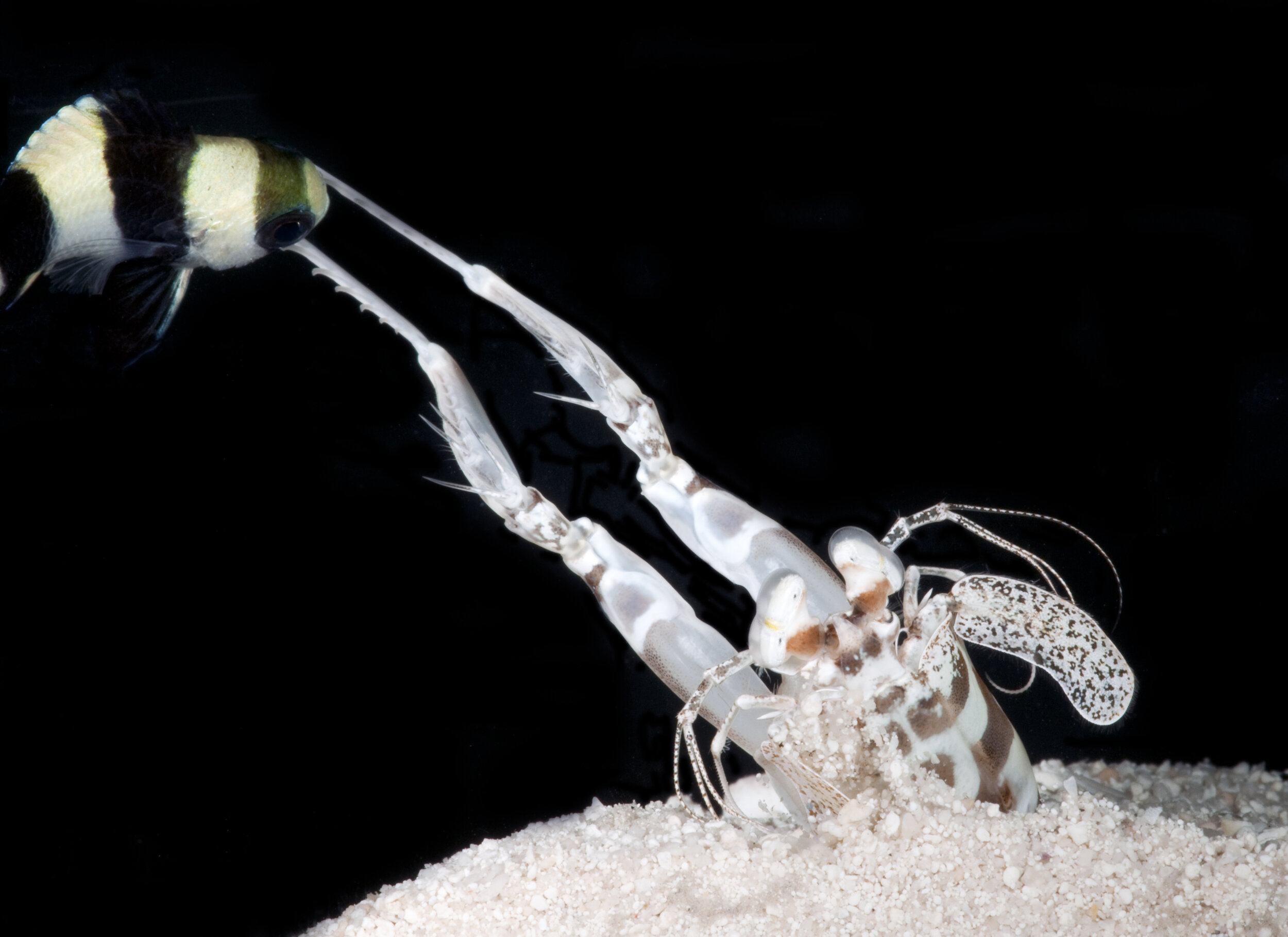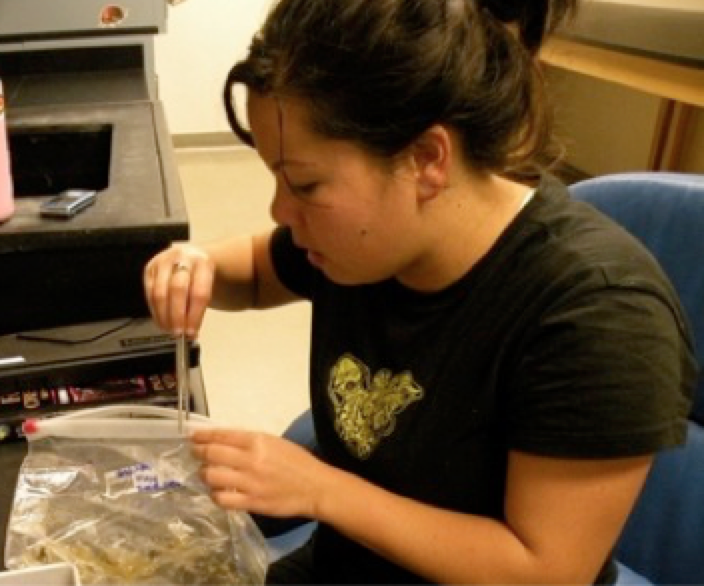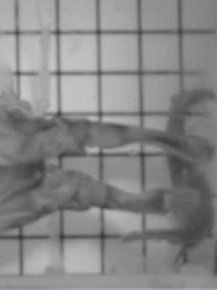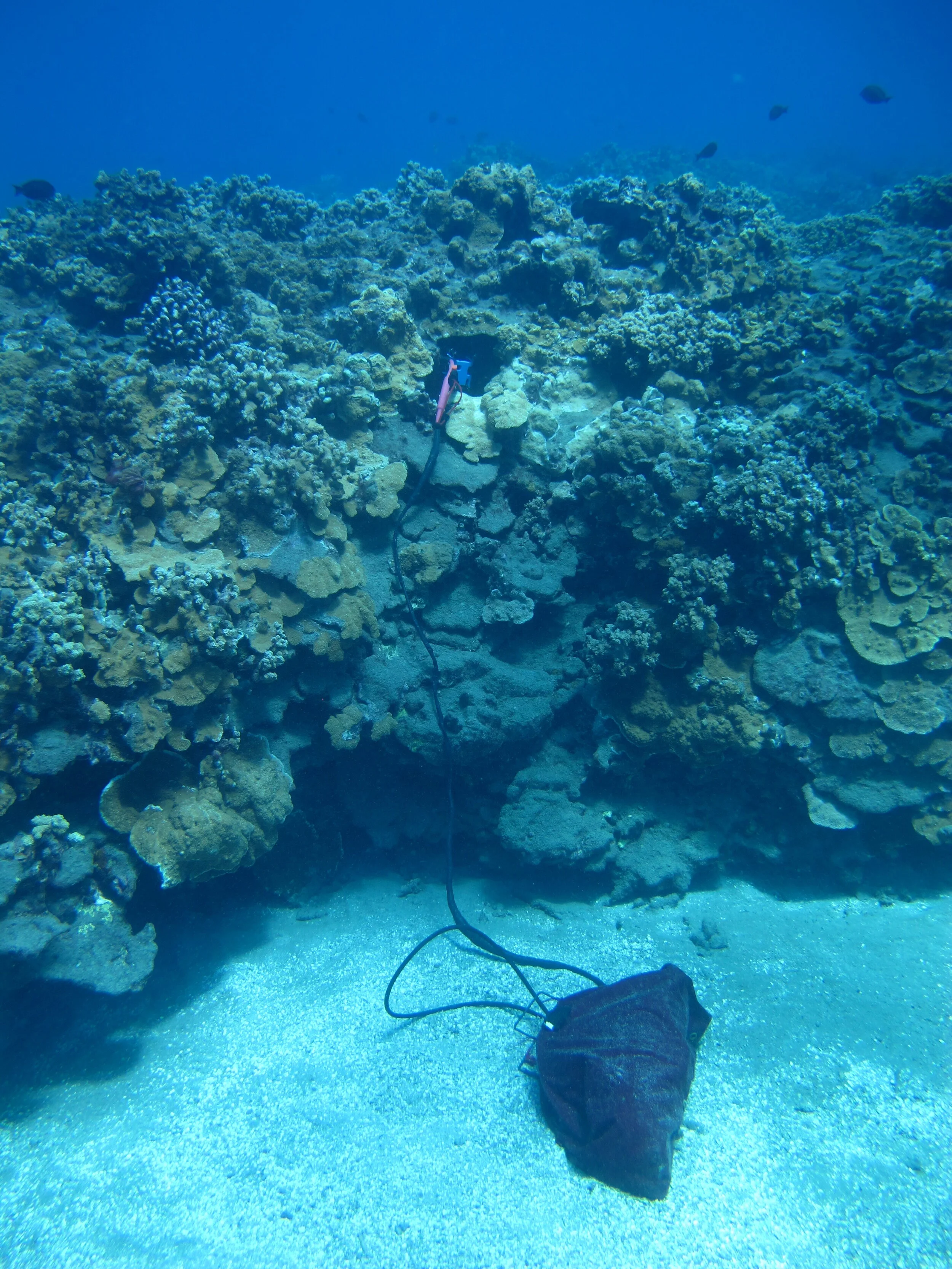Reef flat at the Smithsonian Tropical Research Institute’s Punta Galeta Marine Laboratory, Panamá.
uncovering interactions between morphology, ecology, & environment in reef predators
Lysiosquillina sulcata spearing a fish. (Photo: Roy L. Caldwell)
A foundational tenet in animal ecology is that species with specialized feeding morphology consume very specific prey types. Understanding the diet-morphology relationship has provided valuable insights into the ecological and evolutionary processes that shape morphological diversity and that underlie community structure.
Our research suggests, however, that highly specialized feeding morphology is not necessarily associated with diet specialization. Instead, animals considered to be specialists consume a wider range of prey than would be predicted based on their morphology alone.
Mantis shrimp crustaceans are often touted as having highly specialized feeding morphology, because their raptorial appendages produce among the most powerful strikes ever reported in the animal kingdom. Mantis shrimp are typically divided into two functional groups: spearers that unfurl streamlined appendages to capture soft-bodied prey and smashers that use hammer-like appendages to break hard-shelled prey. Although smasher appendages are highly specialized to produce forceful strikes for breaking hard prey, some species have been observed consuming soft-bodied fish and worms.
We combine tools in biomechanics, animal behavior and stable isotope ecology to determine what governs diet breadth in spearers and smashers and how environment influences the relationship between diet and morphology.
Spearing and smashing mantis shrimp. Left: The smasher, Gonodactylus childi, in lateral view and its raptorial appendage that is specialized to produce powerful strikes. Right The spearing mantis shrimp, Raoulserenea moorea, and its elongated, streamlined raptorial appendage. Figure: deVries. 2017. Biology Letters; Images: R. L. Caldwell and T. Claverie.
Key predators in coral reef food webs
Neogonodactylus bredini smashing a snail. Photo: Roy L. Caldwell.
Testing ecological and evolutionary correlations between morphological and diet specialization requires accurate descriptions of appendage morphology and diet over a range of spatial and temporal scales. We use stable isotope analysis (SIA) to accurately quantify diet. Coupling this technique with laboratory feeding experiments and field studies, we have analyzed the diet in the smasher, Neogonodactylus bredini. and found that, counter to expectation, smashing appendages allow N. bredini to consume both hard- and soft-bodied prey, thereby broadening diet breadth.
Thus, mantis shrimp may be important links between reef flat macro-invertebrates and larger, mobile animals because mantis shrimp consume many different prey and are also consumed by a diversity of larger predators. We are now working to determine the role of mantis shrimp as key predators in coral reef food webs.
A new phase of this research is to determine how these trophic interactions may shift under environmental and anthropogenic disturbances. At the Smithsonian Tropical Research Institute’s Punta Galeta Marine Laboratory where this research occurs, there are habitats with varying degrees of anthropogenic disturbance, from relatively undisturbed reef flats to those within close proximity to the Panama Canal. By expanding stable isotope analysis across the diversity of organisms in the reef flat in combination with the use of robotics to access cryptic habitats we will be able to track shifts in trophic dynamics in response to disturbance.
The role of feeding morphology and competition in governing diet breadth
Former undergraduate mentee, Julie Hassen, preparing tissue samples for stable isotope analysis.
To lay the foundation for answering comparative questions in trophic morphology and ecology across mantis shrimp, we examined the diet breath of a smasher and a spearer species that co-occur in coral rubble habitats. Surprisingly, we found that the spearer has a wider diet breadth than the smasher, suggesting that both species consume hard-shelled prey but that the spearer is more adept at capturing evasive prey. This finding has opened new avenues of research to determine how spearers break hard-shelled prey and to answer ecological questions about the extent to which competition governs diet breath.
Environmental effects on mantis shrimp exoskeleton and mechanics
Former mentee, Victoria Morgan, preparing samples of mantis shrimp exoskeleton for testing in a nanoindenter materials testing machine. Photo: Emily L. A. Kelly.
We investigate whether the potential impacts of climate change stressors, namely ocean acidification (OA) and ocean warming, could directly impact feeding mechanics and diet in Neogonodactylus bredini by modifying the integrity of the smashing appendage.
With collaborators in physiology, biomechanics, and engineering at Scripps Institution of Oceanography and the Department of Bioengineering at UC San Diego, we have found that indicators of oxidative stress, the ultrastructure, mineral content, and material properties of the appendage exoskeleton, show no significant responses to OA conditions. These results indicate that, unlike other intertidal organisms, N. bredini tolerates an expanded range of pH and temperature without experiencing oxidative stress or changes to the exoskeleton, thereby leaving the integrity of the predatory appendage intact.
Our next steps are to determine what characteristics of mantis shrimp physiology and appendage material properties allow for its high tolerance to OA and warming conditions. We are also examining whether the combined stress of OA and low food conditions yield measurable changes in feeding behavior, muscle physiology, and exoskeleton mineralization.
Is smashing always a success? How a smashing mantis shrimp consumes both hard-shelled and soft-bodied prey.
Neogonodactylus bredini spearing a shrimp prey. Image is a single frame from a high-speed video filmed at 20,000 frames per second.
The smashing mantis shrimp, Neogonodactylus bredini uses a repertoire of behaviors to consume different prey. In collaboration with The Taylor Lab at Scripps Institution of Oceanography we are working to examine the feeding behaviors that N. bredini uses to consume hard-shelled clams and evasive grass shrimp in detail using high-speed videos of prey capture events. We are finding that the strikes used to break clams are much faster than those used to capture grass shrimp. N. bredini also grabs grass shrimp with its maxillipeds, suggesting that it does not rely solely on its powerful strikes to capture prey.
Leveraging technology to explore cryptic habitats
Investigating a hole inside the reef matrix using a GoPro on a selfie stick and a pH and temperature sensor attached to a data logger (SeaFET inside the gear bag) in a coral reef of West Maui, Hawaii.
What is life like inside cryptic coral reef habitats?
Coral reefs are among the most diverse ecosystems in the world. Despite the incredible biodiversity that has already been documented, true coral reef diversity remains largely a mystery, because current technology has limited the study of reefs to only their outer surfaces. Coral reefs are massive, three-dimensional structures with many tunnels and crevices that make up the coral reef framework. The majority of species living within reefs and the biological, ecological, and chemical processes that sustain these unique ecosystems remain undiscovered, simply because it has been impossible to access internal reef structures non-destructively.
Exploring inside coral reefs is becoming more imperative as anthropogenic threats to the ocean, such as climate change, pollution, and overfishing, drive the disappearance of healthy reefs worldwide. Ocean acidification (OA) is of particular concern. The acidity of the world’s oceans is increasing at an unprecedented rate, which is dramatically changing ocean ecosystems. OA profoundly alters the hard structures of many calcifying marine organisms, including ecologically important species of corals. Yet, the question of how entire reef ecosystems respond to OA remains largely unresolved because researchers are limited in their abilities to evaluate how OA will affect the internal reef structure. This information is critical because it will help determine how reefs may cope with and potentially adapt to future OA conditions.
In an effort to understand the processes that sustain coral reefs, we have begun a new project collaborating with the The Sandin Lab at Scripps Institution of Oceanography and The Bioinspired Robotics and Design Lab in Mechanical and Aerospace Engineering at UC San Diego. We aim to turn the reef “inside out” to answer two basic questions: 1) who lives inside coral reefs and 2) what is the environment like there. Answers to these questions will reveal currently undiscovered organisms as well as critical information about the environment that sustains these diverse ecosystems.
Coral reefs are not the only habitats with under-explored cryptic habitats. Rocky habitats and kelp forests just right on the coast of California are very accessible and similar exploration questions apply. Underwater robotics opens new and exciting opportunities to answer these fundamental questions about the biodiversity of life on Earth.
understanding the role of morphology in Shifting trophic dynamics and ecosystems
Urchin barren, Point Loma, San Diego (Photo: Kyle McBurnie)
How the feeding apparatus of the purple sea urchin scales to large ecosystem shifts
Co-first author and former undergraduate mentee, Summer Webb, developing urchin experiments.
Purple sea urchins provide a classic example of how feeding morphology can influence an ecosystem. Urchins with their strong jaw morphology coupled with their life history strategies have the ability to decimate kelp forest communities. In California, we have seen a huge shift in trophic dynamics of kelp forests due to anomalous warm water events and prolific urchins stripping the sea floor of kelp leading only urchin barrens behind.
With collaborators from the The Taylor Lab at Scripps Institution of Oceanography, we have examined how the morphology of the Aristotle’s Lantern potentially changes with food abundance. As kelp decreases, how does jaw morphology respond to be able to take advantage of alternate food sources? A longstanding hypothesis in the literature stated that urchins maintain or even grow the jaws of their lantern in order to maintain feeding efficiency and this is one reason why they may be so efficient at decimating kelp forests. We found that the jaws do not grow and instead urchins shrink their tests around their jaws, so jaw size does not change. Starved urchins may just be hungry and therefore eat more.
Moving forward, we are curious how this interaction between kelp forests and urchin barrens may shift under future ocean conditions. We are approaching this question from the perspective of the urchin. How will the test and jaws withstand future conditions? Will they still have the morphology they need to be effective consumers? Surprisingly, the information on test and jaw composition is limited. These questions are becoming especially relevant as El Nino events become more intense, and in the case of Northern California, urchin predators like the sunflower sea star are succumbing to disease. How is it that urchins are able to be such efficient consumers and even in times of starvation? And how do urchin populations have to shift in order for kelp to be able to recruit? What limits urchin populations? These are the kinds of questions that we look forward to pursuing in this new research direction.









